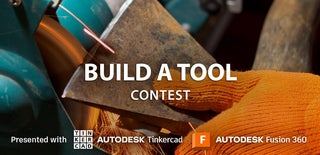Introduction: Dustproof Computer
The ultimate tool: A computer that can survive anything.
Dust is the computer killer.
Follow along on this mad journey as I explain how to built a PC worthy of any workshop.
This is a 61lb, dust proof (and possibly bullet proof) monster.
Supplies
Tools:
- Plasma cutter (or an alternative method for cutting sheet goods).
- Angle Grinder
- Welder
(The holy trinity of metal working)
Materials:
- Computer components
- K&N automotive filter
- Paint
- Hardware
(For a complete list, see my Bill of Materials)
Total cost was ~$3,530 for these top-of-the-line components.
Step 1: Research
- Figure out your desired computer parts.
PC Part Picker is a good resource for this, because it does a good job of filtering out incompatibility.
- Put together aBill of Materials so that everything is organized and easy to reference.
- Confirm your motherboard dimensional specs.
Motherboards come in various form factors. ATX (specs) is the most common for full-sized desktop machines.
- Figure out how to mount your motherboard. Protocase is an excellent resource for this. They have good info and offer a free 3D template which is helpful for confirming dimensional accuracy and positioning.
Step 2: Plan (2D)
- Purchase the various components.
- Measure them, ideally with great accuracy, and sketch those dimensions into any 2D linework editor. Side view, and front view should suffice.
- Keep moving things around until you are happy with the layout and spacing.
- Finalize the layout as much as possible in 2D. It will make transitioning to 3D easier.
Step 3: Finalize (3D)
- Reference the 2D drawing and model everything in 3D. Components can still be rough: This isn’t a rendering (notice the solid green chunk representing a CPU cooler).
- Design in tolerance for fit.
- Design in an assembly plan. (notice the partial-height tabs and respective slots, which allow for easy assembly and plug-welding.)
- Extrapolate 2D cut-profiles from each part once the 3D design is finalized.
Step 4: Cut
- Choose the material (10 gauge steel pictured)
- Choose your cutting process. It is feasible to cut on any of the following CNC machines, especially if you are not committed to using steel as your material:
- Plasma (pictured)
- Fiber Laser
- Waterjet
- Router
- Mill
- CO2 laser (for wood or plastic)
- Manually(jig saw)
- Import the final linework for each part into CAM software and create toolpaths.
- Cut the parts.
- Clean up the cuts in preparation for joining.
Step 5: Join
- Align and assemble according to the joining method that was designed for. (welding in this case)
- With enough interlocking features, jigs can be avoided.
- Tack weld everything in place.
- Finish welding (stitch weld) after confirming everything fits.
- Grind the welds flush.
- Clean the surfaces of any slag.
- Sand everything in preparation for paint.
Step 6: Paint
- Here is an odd painting technique I learned from an old product design documentary. The concept is that a product can look better with age, if the knicks and dents add interest.
- Start with a base coat. (red in this case)
- Then spray a top coat. (black in this case)
- Then (optionally) beat it up now to quicken the aging process. Orbital or hand sanding works well to expose large splotches of the under-coat. A flap-disc works well for getting down to the bare metal and burning the paint into cool patterns.
- Spray a clear coat to keep it from rusting. (or don’t)
Step 7: Assemble
- Watch thisLinus video.
- Install the fans from top-down and tuck wires flush, against the case, exiting downward.
- Install the filter plate (where the filter fits inside).
- Install the motherboard components on a bench for slightly easier assembly. The CPU cooler heatsink prevents access to one of the 9 motherboard mounting points. If that matters, delay installing the heatsink portion.
- Install the motherboard assembly into the case.
- Install the GPU support bracket, then the GPU itself. (Add a spacer, or grind down a lego to make contact with the GPU on the far end)
- Install the power supply.
- Connect and tidy up all cables.
Step 8: Boot, Test, and Admire
- Watch this part of that Linus video again.
- Confirm the resting CPU temp is around 30C.
- Adjust your bios settings to unlock your full RAM potential.
- Take note of your (Asus only) CPU “SP” score (Advanced Bios Tab). SP of 80 or less can be bad. 90 or higher is often good.
- Install you operating system (Windows in my case).
- Install Cinebench R23
- Install HWinfo64
- Run both, and note your final score and how high your max CPU temp gets.
- You should score 27,000+ and have max CPU temps of <90C. (if you built a monster PC like this)
- If your CPU temps are higher than 90C AND your SP score (in bios) was poor (low 80s or less) then you may have gotten unlucky in the silicon lottery. Return the CPU and try again, or undervolt in BIOS to keep temps low if need be. Peak temps should not exceed 100C.
- If your CPU temps are higher than 90C AND you have a decent SP score, then you may have to try installing the thermal paste again.
- Thermal paste tip: Do as the CPU cooler instructions advise. Don’t bother trying to “evenly spread”. One small blob in the center, four smaller ones in corners and you are good-to-go. Use alcohol to clean and try again if need be.
For more information, additional product shots, and a build-video be sure to:
Check outmy website:
Thanks.

Participated in the
Build a Tool Contest













